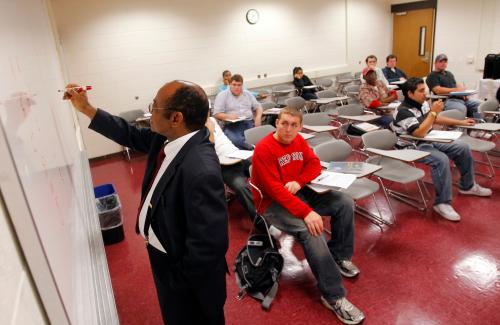Gender inequalities persist in the academy, preventing both white women and women of color faculty from making the scholarly and curricular contributions that only they can make. As smart as we academics are, we have not figured out a way to rid systemic sexism and gender inequities from faculty life. Even more, when sexism intertwines with other marginalized identities like race, we do even worse at rooting out inequities. In addition to the curricular and scholarly contributions women faculty make that are distinct from men faculty, women faculty of color contribute to increasing the participation and retention of students of color, a major focus of higher education missions. Yet, the academy continues to hinder them from achieving their maximum impact.
As we celebrate Women’s Herstory Month, I must acknowledge my somber mood, as female tenured associate professors are fewer in number now than when my colleagues and I began looking at the data in 2003. We began the Women in the Academy study to uncover what was behind a then 75-year stagnant number of women faculty. The research literature we reviewed as we commenced this effort was generally discouraging:
- Women made up 31 percent of full-time faculty in U.S. higher education, an increase of a meager 5 percent over the previous 75 years. For context, the number of women enrolling and earning college degrees has tripled during this period.
- According to the American Association of University Women, among tenured faculty at four-year institutions, just 27 percent were women.
- As implied by the narrowing share of women moving up ranks, appointments at the associate professor rank, usually granted with tenure, disproportionately did not go to women.
- Women experienced disproportionately high rates of leaving academia by their second or third semesters.
“Female tenured associate professors are fewer in number now than when my colleagues and I began looking at the data in 2003.”
In summary, the literature on women faculty at the time suggested that the faculty socialization process, rather than being a positive force, “work[s] to the disadvantage of women in academe [and] continue[s] to exert a strong, if increasingly unheralded impact” on their tenure and promotion.
With that gloomy backdrop, my colleagues and I wanted to know what caused women faculty to stay or leave the tenure journey, particularly at doctoral-granting universities where the disparities were the greatest. Dana Christman’s synthesis of the literature on women faculty argued that in order to begin the process of transforming the academy to address sexism and gender inequities “the academy must commit to an honest attempt to understand women faculty members’ experiences.” The Women in the Academy study sought to listen, understand and examine specific events that women faculty voiced as critical to their experience.
Women in the Academy was a longitudinal study of 22 women faculty conducted by members of my research team and me from 2003 to 2012. Though we did not talk to hundreds of women as a qualitative study, we probed deeply into each participant’s experiences on the tenure track in order to explore commonalities behind the low retention, promotion, and tenure rates for women faculty. Participants for the study included seven women faculty of color and all women were from one of two public, doctoral-granting, predominantly white universities in the mid-Atlantic and Northeast U.S. The women represented over 10 different disciplines from communication to science.
We followed the women every year on the tenure track until either one year after they earned tenure or until they left the institution without earning tenure. Allow me to share with you some of the primary lessons that we learned after nine years in the field collecting interview data from the women on their most challenging and triumphant experiences on the tenure track
“White women faculty and women faculty of color experience sexism and racism, as well as other forms of intersectional oppression, and they experience a great deal of joy in faculty life.”
First, all experienced highs and lows. White women faculty and women faculty of color experience sexism and racism, as well as other forms of intersectional oppression, and they experience a great deal of joy in faculty life. They strive to make key contributions to academia in their teaching and scholarship and thrive in doing so.
Second, the intersections of different identities matter. Commonly used models of socialization, like the newcomer adjustment model, generally do not account for gender, race, or other aspects of faculty’s intersecting identities. By examining this context, we documented the ways in which gender and race (among other marginalized identities) influenced women faculty’s understanding of what it took to earn tenure, their belief in their ability to earn tenure, and the insiders/outsiders who supported their tenure.
Third, relationships matter to the career satisfaction and institutional fit for women faculty. Current reward structures do not promote or affirm women faculty in research universities. Women faculty were often isolated based on their marginalized identities; those who thrived sought out making meaningful connections with co-researchers, students, faculty, and administrators. Often, they pursued these supportive relationships in spite of discouraging messages they received from department chairs and deans who emphasized independent scholarship. These relationships ended up paying dividends in the tenure evaluation process: Women faculty often utilized multiple external sources of support (from peers, family, and friends) rather than institutional support (from deans, chairs, and tenured faculty), defying established (and very often gendered) norms.
Overall, when we started the Women in the Academy study, much of the literature documented the challenges and hardships women faculty faced. In our study, though there were isms to navigate (e.g., sexism and racism), we documented the gifts of meaning, fulfillment, and inspiration women faculty found along the tenure track journey. When asked why stay in a system that often displayed sexism and racism, among other systemic structures that served to make faculty life inequitable, the women in our study relayed story after story of the work they were privileged to do with students.
Today, some 16 years after we began the Women in the Academy study, the overall number of women full-time faculty increased from 31 percent to 45 percent. Though these numbers seem brilliant at first glance, the patina fades upon realizing that these increases are from more women faculty hired in the roles of instructors, lecturers, and assistant professors—all untenured ranks. The higher on the ladder you look, the fewer tenured women there are, showing the same gendered inequities persist. Case in point: in 2016, women represented 26 percent of all tenured professors, down a notch from the 27 percent mark in 2003. At best, the process of advancing through tenure remains stagnant for women professors, at worst, some could say women ascending the professor ladder is now harder than ever.
If students are to reap the benefits of the curricular and scholarly contributions only women faculty can make, we need to put our brains and hearts to work on making the experience of all women full-time faculty in U.S. higher education one without gender inequities.





Commentary
Though more women are on college campuses, climbing the professor ladder remains a challenge
March 29, 2019